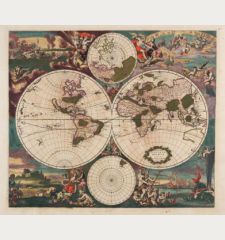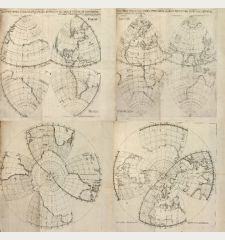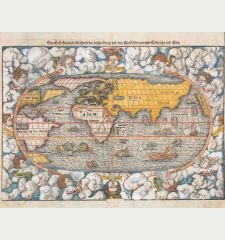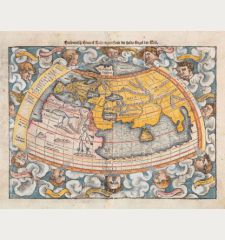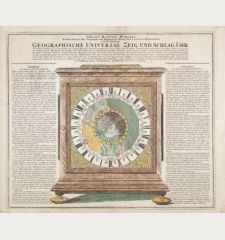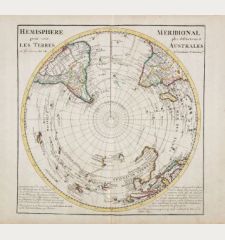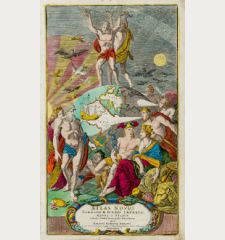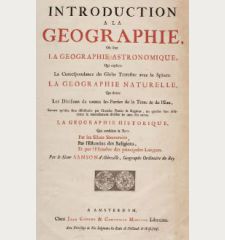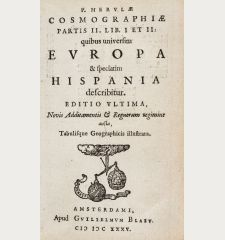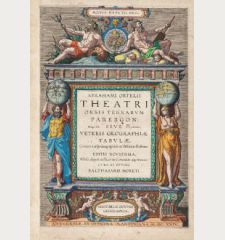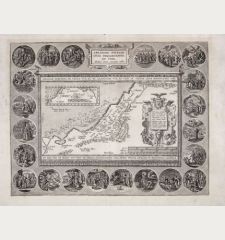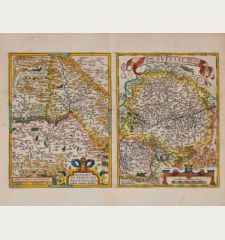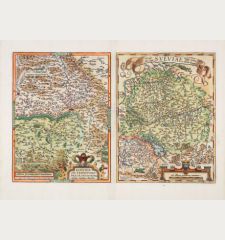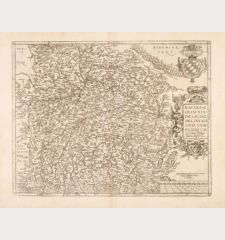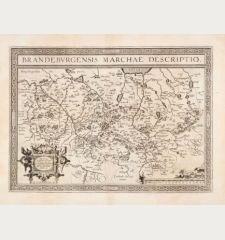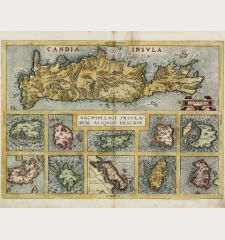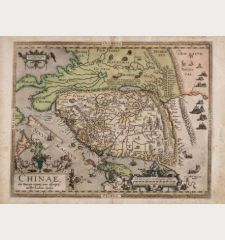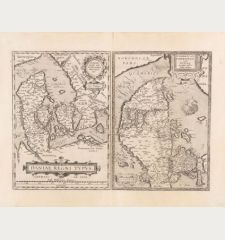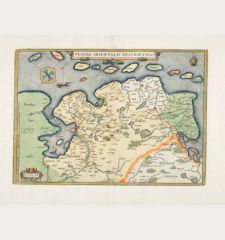Product successfully added to your shopping cart
There are 0 items in your cart. There is 1 item in your cart.
Typus Orbis Terrarum, Americae sive Novi Orbis, Nova Descriptio, Africae Tabula Nova,...
Abraham Ortelius (*1527 - †1598)Reference 12683
Description
Ortelius' World and Continents from the First Modern Atlas.
A fine set consisting of a world map and four of the continents from the first modern atlas Theatrum Orbis Terrarum by Abraham Ortelius. Early old colour examples, each map printed from the first plate. "As the first world map occurring in the first regular atlas, this map is of fundamental importance in the history of cartography." (M. van den Broeke).
R. Shirley describes the Ortelius-Atlas in The Mapping of the World:
For the first time, in 1570, all the elements of the modern atlas were brought to publication in Abraham Ortelius' Theatrum Orbis Terrarum. This substantial undertaking assembled fifty-three of the best available maps of the world by the most renowned and up-to-date geographers.
Unlike earlier compositions such as the Italian composite or 'Lafreri' atlases, each of Ortelius' maps was engraved specifically for his atlas according to uniform format. Through its launching, pre-eminence in map publishing was transferred from Italy to the Netherlands leading to over hundred years of Dutch supremancy in all facets of cartographical production.
World: Typus Orbis Terrarum
The beautiful world map in an oval projection is surrounded by clouds, above the title in a scroll-work cartouche. At the bottom a quote by Cicero, in translation, For what human affairs can seem important to a man who keeps all eternity before his eyes and knows the vastness of the universe? Decorated with a galleon and two sea monsters. This is the first edition, printed from the first of 3 plates which Ortelius used for his atlases. From the 1584 Latin edition of the Theatrum Orbis Terrarum.
Geographically, the map is mainly based on Mercator's large map of the world, which was published a year earlier in 1569 and is only preserved in three copies. Ortelius also used the 1561 world map of Giacomo Gastaldi and Diego Gutierrez' portolan chart of the Atlantic. South America retains the unusual bulged southwest coast, which is no longer present in the later edition of 1589. The cartography of North America is largely speculative apart from the colonial centres in the Caribbean and central Mexico. The Atlantic coast extends too far east, the discoveries of Giovanni de Verrazzano and Jacques Cartier, such as the St Lawrence River are already depicted. The Chesapeake Bay is still undiscovered, the Mississippi River is not yet drawn despite its discovery in 1540, and the Great Lakes are also missing. The discoveries of the Spanish conquistador Francisco Vásquez de Coronado from 1540-42 in the western USA, such as the mouth of the Colorado River, are depicted. Quivira in the far northwest refers to the fabled gold country of Quivira, which Coronado sought as far west as Kansas in North America in 1541.
The southern tip of South America is separated from Tierra del Fuego by the Strait of Magellan, discovered in 1520, which is still part of the huge fictitious southern continent Terra Australis Nondum Cognita. The hypothetical southern continent was already supposed in ancient times. It was believed that all seas were surrounded by land, like the Mediterranean. It was not until Francis Drake's circumnavigation of the world in 1577-80 that he realised that the Strait of Magellan was not a channel between two continents and that south of Cape Horn there was only the open sea.
Several mythical islands are marked in the Atlantic, mostly based on questionable reports by little-known seafarers: Brasil, Frisland, Verde, S. Bradain and Drogeo. Legendary is the phantom island Sept Citiz in the middle of the Atlantic Ocean, better known as Antilia. It was said the island has been settled by a Christian community fleeing the Moors in the 8th century, leaving the Iberian peninsula by ship. The island of Saint Brendan in the northeast of South America, marked as Y. de S. Bo., was also considered a fact among scholars at the time this map was created. It was named after the Irish monk Saint Brendan, who supposedly undertook a legendary sea voyage in the 6th century and discovered this island.
Japan is still incorrectly shown as a large round island, Korea is not present. The Southeast Asian islands are already well depicted for the time. The legendary names Lucach, Beach (Land of Gold) and Maletur (Kingdom of the Malays) in the great southern continent Terrae Australis go back to Marco Polo.
America: Americae sive Novi Orbis, Nova Descriptio
One of the most beautiful and important maps of America of the 16th century. It appeared in Theatrum Orbis Terrarum in 3 different versions. The present example was printed from the first plate for the Latin edition of 1573/74. Decorated with four galleons and a sea monster. An impressive title cartouche at lower right, surrounded by a beautiful ornamental frame.
P. D. Burden about Ortelius' map of America in The Mapping of North America:
One of the most famous and easily recognised maps of America, and one that is both functional as well as decorative... Ortelius depicts the discoveries of a number of people on this map, but the general shape of the continent is derived from Gerard Mercator's great twenty-one sheet world map of the previous year. The two of them had a close relationship and shared their knowledge openly with each other. It is recorded that they travelled together through France in 1560. One of the main noticeable features of the map is the bulbous Chilean coastline; this was not corrected until his third plate. A strategically placed cartouche hides a complete lack of knowledge of the southern waters of the Pacific. Once through the Strait of Magellan the voyager's sea route took him on an almost direct course for the East Indies. No sight had been made of a large continent but conventional wisdom had it that there had to be as much land in the southern hemisphere as in the northern. This was not fully dispelled until the second voyage of the remarkable Captain James Cook in 1772-75. The west coast of North America is shown too far west, as was common at the time. There is no new nomenclature shown.
Asia: Asiae Nova Descriptio
A scarce first edition example of Ortelius' important map of Asia. It covers all Asia from the Mediterranean to the Pacific. With the Arabian Peninsula, India, Thailand, China, Japan, Korea as an island, Java, Borneo, Moluccas (Spice Islands), New Guinea and the Philippines. Decorated with a beautiful title cartouche and two sailing ships. From the early Latin edition of the Theatrum Orbis Terrarum published in 1573/74.
Africa: Africae Tabula Nova
Very decorative map of Africa by Ortelius. It is largely based on the large wall map of Africa by Gastaldi (1505-1566) from 1561, but Ortelius also used information from Mercator's world map of 1569 for this map. With a beautiful title cartouche, a dramatic sea battle and three sea monsters. From the early Latin edition of the Theatrum Orbis Terrarum published in 1573/74.
Europe: Europae
An early example of Ortelius' map of Europe from the first plate. Decorated with a sailing ship, compass rose and tents in Russia. The title cartouche shows Europa, the mother of King Minos of Crete, sitting on Zeus in the form of a bull. From the early Latin edition of the Theatrum Orbis Terrarum published in 1573/74.
Details
| Cartographer | Abraham Ortelius |
| Title | Typus Orbis Terrarum, Americae sive Novi Orbis, Nova Descriptio, Africae Tabula Nova, Asiae Nova Descriptio, Europae. |
| Publisher, Year | Gielis Coppens van Diest, Christoffel Plantin, Antwerp, 1573-1584 |
| Plate Size | 33.6 x 49.4 cm (13.2 x 19.4 inches) |
| Sheet Size | 43.3 x 55.4 cm (17.0 x 21.8 inches) |
| Reference | Shirley, R. W.: The Mapping of the World, No. 122; Van den Broecke, M.: Ortelius Atlas Maps, No. 1, 4, 6, 8, 9; Van der Krogt, P.: Koeman's Atlantes Neerlandici, 0001:31A, 1000:31A, 8000:31A, 8600:31, 9000:31A; Burden, P. D.: The Mapping of North America No. 39 state 2; Betz, R. & P., The Mapping of Africa, No. 12. |
Condition
Cartographer
Images to Download
If you like to download the image of this map with a resolution of 1200 pixels, please follow the link below.
You can use this image for publication on your personal or commercial websites for free if you set a link to this website. If you need photographs with a higher resolution, please contact us.
World Maps - Ortelius, Abraham - Typus Orbis Terrarum, Americae sive Novi...


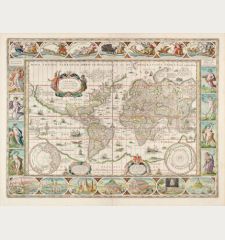
![Ch'onha Chido [Atlas of all under Heaven] Ch'onha Chido [Atlas of all under Heaven]](https://www.vintage-maps.com/3336-home_default/anonymous-korean-manuscript-atlas-chonha-chido-1820.jpg)
![Ch'onha Chido [Atlas of all under Heaven] Ch'onha Chido [Atlas of all under Heaven]](https://www.vintage-maps.com/4291-home_default/anonymous-korean-manuscript-atlas-chonha-chido-1800.jpg)
